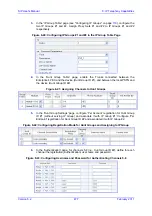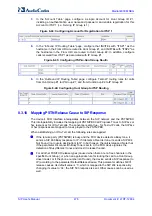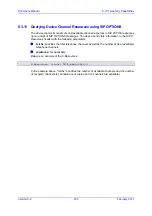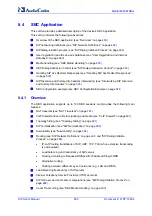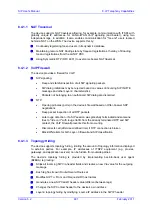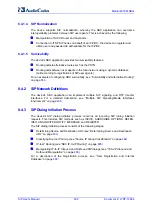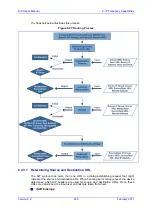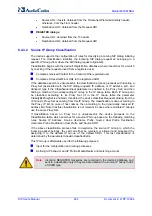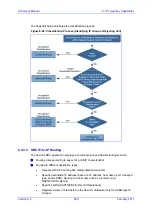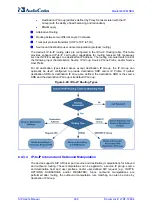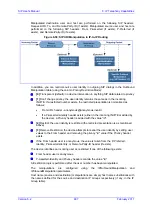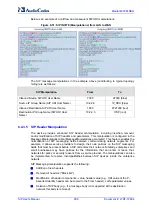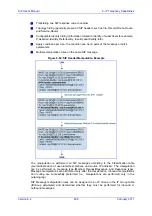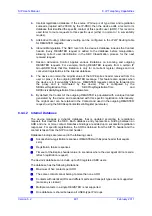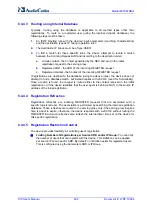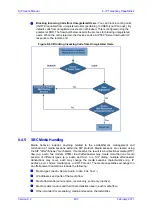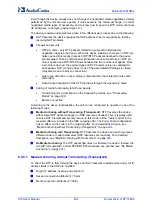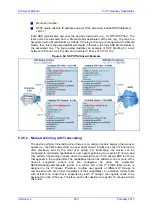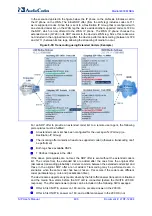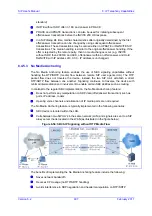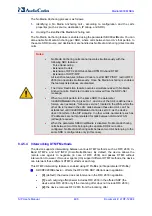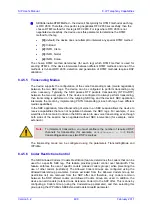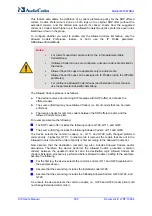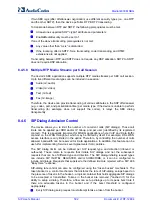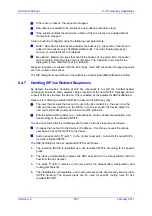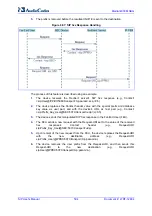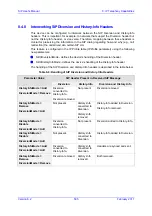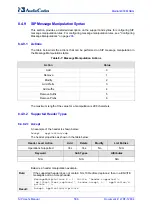
Version 6.2
491
February 2011
SIP User's Manual
8. IP Telephony Capabilities
4.
Internal registration database: If the source IP Group is of type User and registration
succeeds (replied with 200 OK by the IP-PBX), then the device adds a record to its
database that identified the specific contact of this specific user (AOR). This record is
used later to route requests to this specific user (either in normal or in survivability
modes).
5.
Alternative Routing: Alternative routing can be configured in the IP2IP Routing table
for REGISTER requests.
6.
Inbound Manipulation: The SBC record in the device's database includes the Contact
header. Every REGISTER request is added to the database before manipulation,
allowing correct user identification in the SBC Classification process for the next
received request.
7.
Session Admission Control: Applies various limitations on incoming and outgoing
REGISTER requests. For example, limiting REGISTER requests from a certain IP
Group/SRD. Note that this limitation is only for concurrent register dialogs and not
concurrent registrations in the internal database.
8.
The device can retain the original value of the SIP Expires header received from the
user or proxy, in the outgoing REGISTER message. This feature also applies when
the device is in “survivability” state (i.e., REGISTER requests cannot be forwarded to
the proxy and is terminated by the device). This is configured by the
SBCUserRegistrationTime, SBCProxyRegistrationTime, and
SBCSurvivabilityRegistrationTime parameters.
9.
By default, the Contact of the outgoing REGISTER is populated with a unique Contact
generated by the device and associated with this specific registration. Alternatively,
the original user can be retained in the Contact and used in the outgoing REGISTER
request (using the SBCKeepContactUserinRegister parameter).
8.4.4.2 Internal Database
The device manages a dynamic database that is updated according to registration
requests that traverse the SBC. Each database entry represents a binding between an
AOR and one or more contact. Database bindings are added upon successful registration
responses. For specific registrations, the AOR is obtained from the SIP To header and the
contact is taken from the SIP Contact header.
Database bindings are removed in the following cases:
Successful de-registration responses (REGISTER with Expires header that equals
zero)
Registration failure responses
Timeout of the Expires header value (in scenarios where the user agent did not send a
refresh registration request)
The device's database can include up to 200 registered SBC users.
The database has the following limitations:
Maximum of five contacts per AOR
The same contact cannot belong to more than one AOR
Contacts with identical URIs and different ports and transport types are not supported
(same key is created)
Multiple contacts in a single REGISTER is not supported
One database is shared between all USER-type IP Groups
Содержание Mediant 800 MSBG
Страница 2: ......
Страница 366: ...SIP User s Manual 366 Document LTRT 12804 Mediant 800 MSBG Reader s Notes ...
Страница 372: ...SIP User s Manual 372 Document LTRT 12804 Mediant 800 MSBG Reader s Notes ...
Страница 390: ...SIP User s Manual 390 Document LTRT 12804 Mediant 800 MSBG Reader s Notes ...
Страница 404: ...SIP User s Manual 404 Document LTRT 12804 Mediant 800 MSBG Reader s Notes ...
Страница 616: ...SIP User s Manual 616 Document LTRT 12804 Mediant 800 MSBG Reader s Notes ...
Страница 636: ...SIP User s Manual 636 Document LTRT 12804 Mediant 800 MSBG Reader s Notes ...
Страница 652: ...SIP User s Manual 652 Document LTRT 12804 Mediant 800 MSBG Reader s Notes ...
Страница 886: ...SIP User s Manual 886 Document LTRT 12804 Mediant 800 MSBG Reader s Notes ...
Страница 890: ...User s Manual Ver 6 2 www audiocodes com ...

